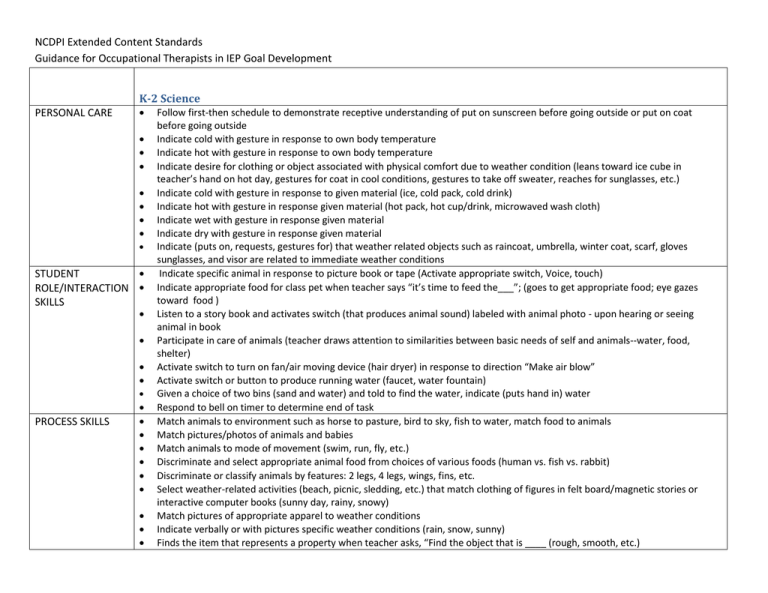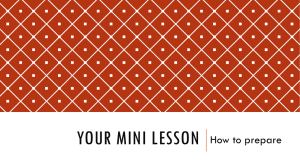NCDPI Extended Content Standards K-2 Science
advertisement

NCDPI Extended Content Standards Guidance for Occupational Therapists in IEP Goal Development K-2 Science PERSONAL CARE STUDENT ROLE/INTERACTION SKILLS PROCESS SKILLS Follow first-then schedule to demonstrate receptive understanding of put on sunscreen before going outside or put on coat before going outside Indicate cold with gesture in response to own body temperature Indicate hot with gesture in response to own body temperature Indicate desire for clothing or object associated with physical comfort due to weather condition (leans toward ice cube in teacher’s hand on hot day, gestures for coat in cool conditions, gestures to take off sweater, reaches for sunglasses, etc.) Indicate cold with gesture in response to given material (ice, cold pack, cold drink) Indicate hot with gesture in response given material (hot pack, hot cup/drink, microwaved wash cloth) Indicate wet with gesture in response given material Indicate dry with gesture in response given material Indicate (puts on, requests, gestures for) that weather related objects such as raincoat, umbrella, winter coat, scarf, gloves sunglasses, and visor are related to immediate weather conditions Indicate specific animal in response to picture book or tape (Activate appropriate switch, Voice, touch) Indicate appropriate food for class pet when teacher says “it’s time to feed the___”; (goes to get appropriate food; eye gazes toward food ) Listen to a story book and activates switch (that produces animal sound) labeled with animal photo - upon hearing or seeing animal in book Participate in care of animals (teacher draws attention to similarities between basic needs of self and animals--water, food, shelter) Activate switch to turn on fan/air moving device (hair dryer) in response to direction “Make air blow” Activate switch or button to produce running water (faucet, water fountain) Given a choice of two bins (sand and water) and told to find the water, indicate (puts hand in) water Respond to bell on timer to determine end of task Match animals to environment such as horse to pasture, bird to sky, fish to water, match food to animals Match pictures/photos of animals and babies Match animals to mode of movement (swim, run, fly, etc.) Discriminate and select appropriate animal food from choices of various foods (human vs. fish vs. rabbit) Discriminate or classify animals by features: 2 legs, 4 legs, wings, fins, etc. Select weather-related activities (beach, picnic, sledding, etc.) that match clothing of figures in felt board/magnetic stories or interactive computer books (sunny day, rainy, snowy) Match pictures of appropriate apparel to weather conditions Indicate verbally or with pictures specific weather conditions (rain, snow, sunny) Finds the item that represents a property when teacher asks, “Find the object that is ____ (rough, smooth, etc.) PLAY WRITTEN COMMUNICATION Given a variety of natural objects of the same type (polished stones vs. brittle rocks vs. jagged rocks OR cotton vs. lamb’s ear leaf vs. cactus, OR sand, clay, composted soil, mud, etc.) identify differing properties of texture (soft, hard, smooth, rough, sharp, slimy, shiny, dull, etc.) Given a variety of natural objects of the same type, sorts objects by color (green leaves, yellow leaves, red leaves) to a chart, color map, or set of containers (may retrieve items on nature walk) Use non-standard tools of measurement to identify length-measure room/table by counting using baseball bat, paper clips, pencils, sea shell Cut lengths of string to compare length of body parts, large and small objects, etc. Identify ruler when teacher asks ‘how long’ an item is Identify scale when teacher asks to see ‘how heavy’ an item is When presented with the need to pour/measure in a cooking activity and presented with a cooking spoon and a measuring spoon, choose measuring spoon Indicate that a clock is used to tell time Demonstrate awareness of bell on timer to indicate change of task Recognize dry soil and indicates need for water Recognize empty water bowl for animal and indicate to add water Recognize what will ‘flow’ by actions: pouring liquids, scooping thick mixtures (pudding), picking up solids Sort animals by structure (body) and how they move Dress doll or bear for different types of weather Given a set of cylinders (soup cans, soda cans, etc.) indicate how to stack and/or how to roll Position cylinders to stack Position cylinders to roll Stack blocks to support balance of tower (starts with large block and uses smaller blocks in sequence to get taller tower) Choose blocks to balance on tower (rejects round objects for square blocks) Choose wide balance beam over narrow balance beam to walk specific distance, to walk and carry heavy objects, etc. Roll ball to knock down pins Choose heavy ball to knock down bowling pins (given two choices – big ball and styrofoam ball) Add block to broad base to stack blocks Produce drawing or representation that has two or more characteristics of a specific animal Choose pictures or create drawings of animals/plants and needs (food, water etc.) to create display of animal/plant corresponding needs Produce drawing or representation that shows life stages of an animal Record temperatures on chart (color code with temperature range – blue/cold, gray/cool, yellow/warm, red/hot) for series of days Create seasons book with pictures/words of activities and places in different seasons



